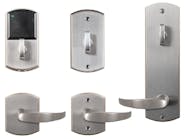With the unfortunate occurrences of violence in schools, a cry went out for the implementation of locking mechanisms that would provide the capability of locking the exterior trim without having to enter the hallway to lock the door.
Lock manufacturers introduced “Intruder” locks for both mortise and cylindrical lock applications. The mechanical (key operated) classroom intruder lock expands the classroom function lock by incorporating double lock cylinder control, enabling a teacher to lock the lock and secure the door from within the classroom. This feature always allows egress while leaving the outside lever locked.
In addition to mechanical classroom intruder locks, there are pushbutton mechanical locks and electromechanical locks. Some pushbutton mechanical locks offer a privacy function that, when activated, disables the keypad. An example is the Kaba Ilco Simplex line of mechanical pushbutton locks.
Electromechanical lock manufacturers have introduced a number of offline and online locks that provided the capability of locking exterior trim. Some also disable the credential reader or keypad. Lock manufacturers can have different names for their products.
Mechanical Classroom “Intruder” locks are available as mortise locks and cylindrical locks. Each lock manufacturer has its own design for its “Intruder” locks. For this article, I will include manufacturers’ explanations for their “intruder” lock functions.
The cylindrical locks are equipped with a keyed cylinder in the outside and inside levers, unlike the traditional Classroom Lock that is equipped with only an outside lock cylinder. Key operation in the outside lock cylinder controls the locking or unlocking of the outside lever.
For the Marks Classroom “Intruder” lock, the outside lever can be locked by the key in either the outside or inside lock cylinder. In addition, when the outside lever is locked by the key using the inside lock cylinder, the outside lock cylinder cannot unlock the outside lever. In both cylindrical locks, the inside lever has free egress.
Classroom Intruder mortise locks are available in different configurations. The base configuration is a double cylinder lock. Like the cylindrical lock, the Classroom “Intruder” mortise lock can be locked from the inside lock cylinder. Depending upon the manufacturer, the names are different.
The basic model is a double cylinder mortise lock equipped with a deadlatch without deadbolt. The function description for this Marks Classroom Security “GG” mortise lock is:
Latch by lever either side except when outside lever is locked from inside or outside by key.
Latch operated by key from inside or outside.
Inside always open.
Auxiliary latch, deadlocks latch.
A second model Classroom “Intruder” is a double cylinder mortise lock equipped with a spring latch and deadbolt. The function description for the Sargent 8239/7839 Classroom Security Intruder Deadbolt is:
Key from either side retracts and projects deadbolt which also unlocks or locks outside trim
Trim outside retracts latchbolt, except when locked
Trim outside is only locked by projecting the deadbolt
Trim inside retracts both latchbolt and deadbolt simultaneously, and unlocks outside trim
The third model is a double cylinder mortise lock equipped with a deadlatch and deadbolt. The function description for the Sargent 8240/7840 Classroom Security Intruder Deadbolt is:
Key from either side retracts and projects deadbolt which also unlocks or locks outside trim
Trim outside retracts latchbolt, except when locked
Trim outside is only locked by projecting the deadbolt
Trim inside retracts both latchbolt and deadbolt simultaneously, and unlocks outside trim
Note: Sargent offers another version, the 8241/7841, which has two operational variations from the 8240.
When the deadbolt is projected, the first rotation of the key retracts deadbolt, and the second key rotation unlocks trim outside.
When deadbolt is projected, the trim inside retracts both latchbolt and deadbolt simultaneously and the outside trim remains locked.
The fourth model is a double cylinder mortise lock equipped with a deadlatch, deadbolt and holdback. The function description for the Schlage L9077/LV9077 Classroom Security Holdback Lock is:
Latchbolt retracted by lever from either side unless outside is locked by key from either side.
When locked, latchbolt retracted by key outside or lever inside. Auxiliary latch deadlocks latchbolt when door is locked.
Depress inside lever and turn key 360° for holdback feature.
Inside lever is always free for immediate egress.
Note: Activating the Holdback function turns the door into a push-pull (latchbolt retracted) operation. The purpose of the Holdback function is to reduce the wear and tear on the lock mechanism (same as dogging an exit device) and eliminates the latching noise when the door closes.
The Holdback function lock cannot be installed onto a fire rated door.
A number of offline and online electromechanical locks provide the ability to lock the exterior trim, not allowing access into the classroom. Each lock manufacturer or access control software (online) has its own methodology for “Intruder” protection.
Some standalone, offline electromechanical locks are available with an inside privacy button that locks the outside trim and/or the methods of access.
Some Simplex mechanical pushbutton locks including the 1021 cylindrical and R8148 mortise are available with the Privacy or lockout functions. When activated, the inside keyed cylinder disables the pushbutton operation. Access is available using the outside key override only.
On the inside trim, the R8148 keyed cylinder has three positions; “L” Lockout, “P” Passage and “C” Code. This way, when you are inside the classroom, there is visible indication of the condition of the lock.
Alarm Lock Trilogy 4100/4500 standalone offline locks are equipped with a privacy pushbutton on the top of the inside lock assembly. Pressing this button automatically disables free passage, locking the lock mechanism and at the same time, locks out general PIN user codes. Access can be gained using the lockdown override code or mechanically using an override key. Inside lever is always free for immediate egress.
Schlage CO Series offline locks have an available privacy (40) function. This button, located on the interior assembly, can lock down the keypad and/or outside credential reader to standard user codes. Inside lever is always free for immediate egress.
Kaba E-Plex locks can have an optional privacy function with a thumbturn on the inside. When the thumbturn is thrown, no access codes or cards are valid. Access can only be gained using the key override or the master code.
Online or networked electromechanical locks have a distinct advantage as they are interconnected electronically. A single command can lockdown every lock on the network. For example, the Alarm Lock Trilogy Networx lock’s factory software has been upgraded to include an emergency global lockdown command. According to Alarm Lock, lockdown of all the programmed Networx Locks occurs within ten seconds of being issued. It will supersede all scheduled programming or updates unless individual locks are otherwise programmed.
For just about every school, college or university, whether they have mechanical or electromechanical locks installed, a lock manufacturer probably makes a compatible “Intruder” lock.
The following is a partial list of lock manufacturers that offer mechanical and/or electromechanical Classroom “Intruder” cylindrical and/or mortise locks, along with their web site addresses.
Arrow Lock: www.arrowlock.com.
Best Access Control Systems: www.bestaccess.com.
Cal-Royal: www.cal-royal.com
Corbin Russwin: www.corbinrusswin.com.
Dorma Architectural Hardware: www.dorma-usa.com.
Falcon: www.falconlock.com.
Kaba Ilco Corp.: www.kabaaccess.com.
Marks USA: www.marksusa.com.
Sargent: www.sargentlock.com.
Schlage: www.schlage.com.
Yale Commercial Lock and Hardware: www.yalecommercial.com.




